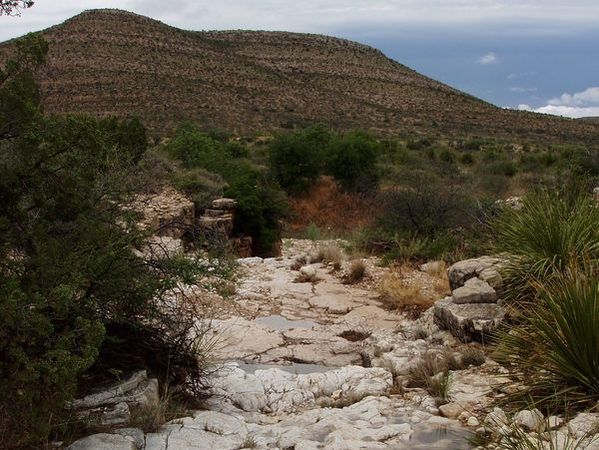The Chihuahuan desert is full of cactus, yucca, and other thorny/spikey/barbed plants mixed into patchy brush. A wrong step, trip or fall can result in painful, or even grave, injury. Travel on foot is a matter of constant attention, picking out a tortuous, haphazard route to stay on relatively clear ground. A dry streambed clear of vegetation provides the rare luxury of travel in a straight line. This shallow channel floor is made up of bedrock slabs in some places, a mix of gravel and small boulders in other stretches. In storms, it carries water running off the desert surface of this small drainage basin rimmed by hills.
Dimensions The streambed, marked here by scattered pebbles and bare bedrock fracture lines, is 5-15 (2-5 m)feet across. It can be followed about a mile (2 km) up into the basin. On this sample map view, line-shaded patches are brush (which commonly includes catclaw), radial pointed blades are lechuguilla, and small gray slashes are prickly pear (see plant descriptions below). The grid has five-foot (1.5 m) spacing. A larger-area image for this schematic map is available for download on the FOR GAME MASTERS page.
Key Details
- A common cactus growing low to the ground here is prickly pear, which has thick, disc-shaped leaves that are a possible source of food and moisture. The strong inch-long needles are an obvious hazard, but the plant has a second layer of very short, hair-like spines that can pierce skin in much greater number and lead to days of discomfort.
- One of the largest plants on the ground away from the channel is lechuguilla, a radiating burst of tough, fleshy leaf blades like a giant aloe vera. These plants are three to eight feet across, and rise about half that high. The curved-upward tips of leaves are hard, with sharp points that can pierce tough hide or rubber vehicle tires.
- In some places the channel has an overhang of brush almost touching the ground. Among these plants is catclaw: thin, flexible branches with small hooked thorns that readily grasp clothing and wrap onto a moving body. This plant hampers movement more than it physically harms.
- The desert hosts ‘sharp’ animals, too: diamond-back rattlesnakes and scorpions. These are rarely encountered, but have the added hazards of poison. In contrast, the sharp plants are always nearby, delivering the bulk of injuries to people traversing the desert.
- The channel is one to three feet lower than the adjacent desert floor, but brush and clusters of other plants add another few feet of block to vision. In some sections of the channel, a walker will have an obscured view of surrounding ground, even quite nearby.
- The channel occasionally steps several feet down a dry cascade of exposed bedrock blocks, with a shallow rock depression at its base. This basin may hold water for a couple days after a rainstorm has passed by. There are wide cracks between beds of the rock, emptying out onto the polished-· looking wavy surfaces of the rock steps.
- Following the streambed or one of its few tributaries up to its very beginning, you will find the channel climbing up a hillside in rough cascades. This steep channel bed may not be easy to climb, but it provides a much longer range view over the stream course and surrounding desert floor.
Story Elements

- The streambed route provides an opportunity to head off others that are picking their way across the desert floor. The alternative strategy, a mad rush across desert floor to avoid or reach a pursuer or quarry that is also following the streambed throughway, is much more chancy.
- A brush/catclaw barrier, or an inconveniently placed rattlesnake, may make a person who is following the streambed divert up onto the desert floor for a short distance. This is a chance for an encounter with some of the cactus and lechuguilla walking complications that are being otherwise avoided.
- A character may have a need to learn to skin a prickly pear leaf while avoiding contact with the long and short spines.
- Rare shade from the hot summer sun is found in the streambed below especially thick brush, or in partial shelter given by hollowed-out stream banks in rare locations where the bedrock is sandy.
- If someone is being tracked, the bare rock sections of the streambed are likely places to lose the trail. On the other hand, this is a very natural place to include the old trope of bits of clothing hooked on, or entangled by, vegetation.
- Combat Dynamics:
- Hand-to-hand fighting among sharp plants of the desert floor offers much more chance of major injury from simply falling down or taking a badly-considered step.
- A carefully-chosen piece of a spikey plant could make an improvised weapon.
- The streambed is likely to be an especially contested place where it crosses a battle line, as a breakthrough here provides an easy way to quickly bypass and flank opponents.
Reference Location
Eastern Guadalupe Mountains, southwest of Carlsbad, southeastern New Mexico. Nearby within five miles (8 km) is the much larger channel of the Boulder Canyon scene, and the same mountain range also hosts the Oasis and Decorated High Gallery scenes.
© Rice-Snows 2017
Proudly powered by Weebly








